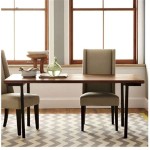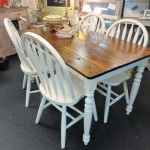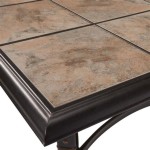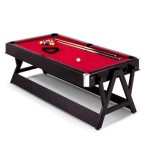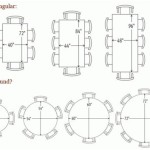The Art of the Elegant Dining Table Centerpiece
The dining table serves as more than just a surface for meals; it is a focal point in the home, a gathering place for family and friends, and a representation of personal style. A thoughtfully chosen centerpiece can dramatically elevate the dining experience, transforming an ordinary setting into an elegant and inviting space. The selection of an appropriate centerpiece requires careful consideration of various factors, including the size of the table, the existing décor, the occasion, and personal preferences. A well-executed centerpiece should not only be visually appealing but also functional, enhancing the dining experience without obstructing views or hindering conversation.
The concept of a centerpiece dates back centuries, evolving from simple floral arrangements to elaborate displays of art and ornamentation. Historically, centerpieces served as symbols of wealth and status, showcasing exotic fruits, rare flowers, or intricate silverware. Today, the purpose remains similar, albeit more accessible: to create a visually captivating and harmonious setting. The modern approach to centerpieces emphasizes balance, proportion, and the integration of various textures and colors to achieve a desired aesthetic.
Understanding the Fundamentals of Centerpiece Design
Creating an elegant dining table centerpiece involves understanding several key design principles. These principles are largely based on visual harmony, balance, and proportion. Neglecting these foundational elements can result in a centerpiece that feels out of place or visually jarring. The first, and perhaps most important, consideration is the size of the table. A centerpiece should be proportional to the table’s dimensions, neither overwhelming the space nor appearing insignificant. For a long rectangular table, a series of smaller arrangements or a longer, linear design is generally more effective than a single, large centerpiece. On a round table, a central piece with radial symmetry often works best.
The height of the centerpiece is another critical factor. A centerpiece that is too tall can impede conversation across the table, creating an awkward and uncomfortable dining environment. As a general rule, the centerpiece should be either below eye level when seated (around 12 inches or less) or significantly above it (over 24 inches). This allows for unobstructed views between diners. Low-profile arrangements, such as a collection of candles or a horizontal display of florals, are often a safe and elegant choice. If height is desired, consider using tall, slender vases or candelabras that allow for clear sightlines beneath the decorative elements.
The color palette of the centerpiece should complement the existing décor of the dining room. Consider the wall color, the style of the furniture, and the overall ambiance of the space. A centerpiece can either blend seamlessly with the existing color scheme for a cohesive look or provide a pop of color to create visual interest. When choosing colors, consider the occasion and the season. For example, warm, autumnal colors like oranges, reds, and browns are well-suited for Thanksgiving gatherings, while lighter, pastel shades are appropriate for spring brunches. Neutral colors, such as whites, creams, and greens, offer versatility and can be easily adapted to various settings.
Exploring Different Types of Centerpiece Materials
The materials used in a centerpiece significantly contribute to its overall aesthetic and impact. There is a wide range of options available, each offering a unique texture, color, and style. Fresh flowers remain a classic and timeless choice, providing natural beauty and fragrance. Consider the type of flowers, their arrangement, and the vessel in which they are displayed. A simple bouquet of roses in a crystal vase can exude elegance, while a more rustic arrangement of wildflowers in a mason jar can create a charming and informal setting. When using fresh flowers, ensure they are properly hydrated and maintained to prolong their lifespan.
Greenery, such as eucalyptus, ferns, or succulents, can be an excellent alternative or complement to fresh flowers. Greenery adds texture and depth to a centerpiece, creating a lush and organic feel. It is also a more sustainable option, as greenery typically lasts longer than fresh flowers and requires less maintenance. Greenery can be used alone in a simple vase or incorporated into a more elaborate arrangement with flowers and other decorative elements. Consider using different types of greenery with varying textures and shades of green to create visual interest.
Candles are another popular choice for dining table centerpieces, adding warmth and ambiance to the space. Candles can be used in a variety of ways, from simple votive candles scattered across the table to elegant candelabras holding multiple tapers. The type of candle and the holder can significantly impact the overall style of the centerpiece. Taper candles in elegant candlesticks create a formal and sophisticated look, while pillar candles in glass hurricanes offer a more relaxed and contemporary feel. Scented candles can also add a subtle fragrance to the room, but be mindful of the scent and ensure it is not overpowering or distracting during meals.
Natural elements, such as stones, wood, and shells, can bring a touch of the outdoors inside and create a unique and organic centerpiece. These elements can be used alone or combined with other materials to create a more complex and textured arrangement. A collection of smooth river stones in a shallow bowl can create a Zen-like ambiance, while a piece of driftwood adorned with air plants can add a rustic and bohemian touch. Shells, particularly those with interesting shapes and colors, can be arranged in a glass vase or scattered across a table runner for a coastal-inspired centerpiece.
Non-traditional materials, such as fruits, vegetables, and decorative objects, can also be used to create interesting and unexpected centerpieces. A bowl of seasonal fruits, such as apples, pears, or citrus fruits, can add a pop of color and freshness to the dining table. Vegetables, such as artichokes, eggplants, or squashes, can also be used in a similar way. Decorative objects, such as antique books, vintage bottles, or small sculptures, can be arranged to create a unique and personalized centerpiece that reflects your individual style. When using non-traditional materials, consider the overall theme and color palette of the dining room to ensure the centerpiece complements the existing décor.
Creating Centerpieces for Specific Occasions
The occasion plays a significant role in determining the appropriate style and materials for a dining table centerpiece. Different events call for different aesthetics, and tailoring the centerpiece to the specific occasion can enhance the overall ambiance and create a memorable experience. For formal events, such as dinner parties or holiday gatherings, a more elaborate and sophisticated centerpiece is typically appropriate. Consider using elegant materials, such as crystal vases, silver candlesticks, and high-quality flowers. The arrangement should be carefully curated and well-balanced, reflecting the formality of the occasion.
For casual events, such as family dinners or informal gatherings, a more relaxed and approachable centerpiece is often preferred. Consider using simpler materials, such as mason jars, wooden bowls, or natural elements. The arrangement can be more informal and whimsical, reflecting the relaxed atmosphere of the occasion. A simple bouquet of wildflowers in a mason jar or a bowl of fresh fruit can be a charming and welcoming addition to a casual dining table.
Holiday centerpieces provide an opportunity to celebrate the season and create a festive atmosphere. For Christmas, consider using traditional holiday colors, such as red, green, and gold, and incorporating festive elements, such as pine branches, ornaments, and candles. For Thanksgiving, focus on warm, autumnal colors, such as oranges, reds, and browns, and incorporate elements such as pumpkins, gourds, and leaves. For Easter, use pastel colors and incorporate elements such as eggs, bunnies, and spring flowers. Tailoring the centerpiece to the specific holiday can enhance the overall celebration and create a memorable dining experience.
Seasonal changes also provide an opportunity to update the dining table centerpiece and reflect the current season. In the spring, use light, fresh colors and incorporate elements such as budding branches, tulips, and daffodils. In the summer, use bright, vibrant colors and incorporate elements such as sunflowers, hydrangeas, and seashells. In the fall, use warm, earthy colors and incorporate elements such as pumpkins, gourds, and leaves. In the winter, use cool, muted colors and incorporate elements such as pine branches, berries, and snow-covered twigs. Adapting the centerpiece to the changing seasons can keep the dining table feeling fresh and inviting throughout the year.

25 Elegant Dining Table Centerpiece Ideas

16 Modern Dining Table Centerpieces You Can Use Year Round

Contemporary Dining Room Ideas To Inspire You

Easy And Elegant Inexpensive Centerpiece Home With Holliday

The 55 Best Christmas Dining Table Centerpieces For 2024

Elegant Dining Room Decor Inspiration With Fine And Crystal Em 2024 Decoração Sala De Jantar Casas

Elegant Neutral Colored Dining Table Centerpiece Round Top Floral Cream Rose And Peonies Tan Brown Arrangement Etsy

Free Elegant Dining Setup Image Download At Stockcake

Centerpieces And Table Decorations For Every Season Balsam Hill

Free Elegant Dining Room Image Download At Stockcake

